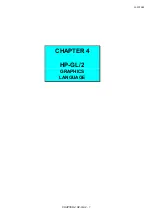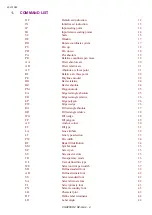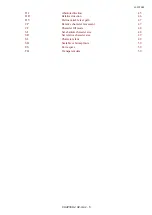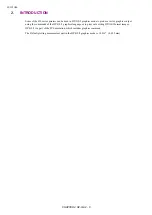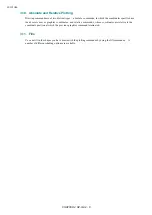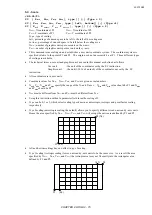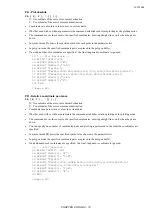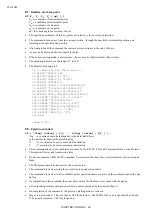
2001/10/02
CHAPTER 4 HP-GL/2 - 7
3.
TERMINOLOGY
3.1.
Picture Frame
The printer frame is the rectangular area of the page on which graphic output can be printed. This is based
on the logical page defined for the selected paper size.
3.2.
Anchor Point
The anchor point of the picture frame is the top left hand corner of the frame. This can be moved on the
page using PCL language page control commands.
3.3.
Graphics Window
The graphics window is the rectangular area of the page on which you can generate graphic output using
HP-GL/2 commands. Initially the graphics window is the same as the picture frame but may be altered using
the HP-GL/2 IW command.
3.4.
Hard Clip Limits
Hard clip limits are the physical restrictions which define where printed output can appear on a page.
3.5.
Soft Clip Limits
Soft clip limits are the user-defined restrictions which define where printed output can appear on a page.
3.6.
Graphics Units
The initial coordinate system employs units of 1/1016" in both the x- and y -axes.
3.7.
User Units
The HP-GL/2 graphics language uses a coordinate system. You can impose your own x- and y -scale units
on this system using the SC command.
3.8.
Current Units
The units in use at a given time are called the current units. Current units are either user units or graphics
units, depending on whether scaling has been turned on or not. The SC command is used to turn scaling
on, that is, to make user units the current units.
3.9.
Pens
By convention, certain HP-GL/2 graphics language commands are thought of as using a pen, which can be
either up or down. To produce plotted output the pen must be down. To move to a location on the page
without producing output the pen must be in the up position. Some HP-GL/2 commands require you to
specify the pen position before you use them, others have implied pen positions built into them, so that
you do not need to specify "Pen up" or "Pen down".
Summary of Contents for HL-1250
Page 15: ...2001 10 02 CHAPTER 1 INTRODUCTION 1 CHAPTER 1 INTRODUCTION ...
Page 20: ...2001 10 02 CHAPTER 1 INTRODUCTION 6 ...
Page 21: ...2001 10 02 CHAPTER 2 PCL 1 CHAPTER 2 PCL PRINTER CONTROL LANGUAGE ...
Page 59: ...2001 10 02 CHAPTER 2 PCL 39 ...
Page 76: ...2001 10 02 CHAPTER 2 PCL 56 ...
Page 104: ...2001 10 02 CHAPTER 2 PCL 84 71 71 Lines picture Same as above ...
Page 109: ...2001 10 02 CHAPTER 2 PCL 89 ...
Page 123: ...2001 10 02 CHAPTER 2 PCL 103 ...
Page 131: ...2001 10 02 CHAPTER 3 PCL5C 1 CHAPTER 3 PCL5C ...
Page 149: ...2001 10 02 CHAPTER 4 HP GL 2 1 CHAPTER 4 HP GL 2 GRAPHICS LANGUAGE ...
Page 199: ...2001 10 02 CHAPTER 4 HP GL 2 51 ...
Page 204: ...2001 10 02 CHAPTER 4 HP GL 2 56 ...
Page 205: ...2001 10 02 CHAPTER 5 PJL 1 CHAPTER 5 PJL PRINTER JOB LANGUAGE ...
Page 248: ...2001 10 02 CHAPTER 5 PJL 44 ...
Page 263: ...2001 10 02 CHAPTER 5 PJL 59 ...
Page 264: ...2001 10 02 CHAPTER 6 EPSON 1 CHAPTER 6 EPSON FX 850 ...
Page 286: ...2001 10 02 CHAPTER 6 EPSON 23 LPRINT CHR 27 CHR 37 CHR 1 CHR 0 Select downloaded characters ...
Page 290: ...2001 10 02 CHAPTER 6 EPSON 27 Sample 12 ...
Page 292: ...2001 10 02 CHAPTER 6 EPSON 29 Sample 14 ...
Page 294: ...2001 10 02 CHAPTER 7 IBM PROPRINTER 1 CHAPTER 7 IBM PROPRINTER XL ...
Page 315: ...2001 10 02 CHAPTER 7 IBM PROPRINTER 22 ...
Page 316: ...2001 10 02 CHAPTER 8 BAR CODE CONTROL 1 CHAPTER 8 BAR CODE CONTROL ...
Page 326: ...2001 10 02 CHAPTER 9 HP GL 1 CHAPTER 9 HP GL GRAPHICS LANGUAGE ...
Page 353: ...10 5 2001 APPENDIX A COMPARISON LIST 1 APPENDIX A COMPARISON LIST ...
Page 391: ...10 5 2001 APPENDIX A COMPARISON LIST 39 AUTOSKIP ON OFF ON OFF ON OFF ON OFF ...









